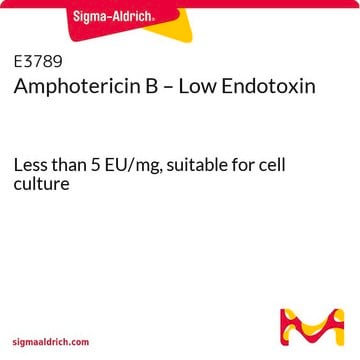F3174
Fpg Protein from Escherichia coli
≥90% (SDS-PAGE), buffered aqueous glycerol solution, >20,000 units/mg protein, suitable for genomic analysis
Synonym(e):
DNA-(apurinic or apyrimidinic site)lyase MutM (APlyase MutM), Fapy-DNAglycosylase, Formamidopyrimidine-DNA glycosylase, Fpg Protein from Escherichia coli, Recombinant, Fapy DNA glycosylase, Formamidopyrimidine DNA glycosylase, MutM
About This Item
Empfohlene Produkte
Biologische Quelle
Escherichia coli
Qualitätsniveau
Rekombinant
expressed in E. coli
Assay
≥90% (SDS-PAGE)
Form
buffered aqueous glycerol solution
Spezifische Aktivität
>20,000 units/mg protein
Mol-Gew.
30.2 kDa (269 amino acids, predicted from the nucleotide sequence)
Zusammensetzung
protein, 0.1- 0.3 mg/mL Bradford
Lagerbedingungen
(Tightly closed)
Methode(n)
nucleic acid detection: suitable
UniProt-Hinterlegungsnummer
Anwendung(en)
genomic analysis
Versandbedingung
wet ice
Lagertemp.
−20°C
Angaben zum Gen
Escherichia coli CFT073 ... mutM(1038243)
Escherichia coli K12 ... mutM(946765)
Allgemeine Beschreibung
Research area: Cell signaling
Anwendung
Biochem./physiol. Wirkung
Einheitendefinition
Physikalische Form
Lagerklassenschlüssel
10 - Combustible liquids
WGK
WGK 2
Flammpunkt (°F)
Not applicable
Flammpunkt (°C)
Not applicable
Persönliche Schutzausrüstung
Eyeshields, Gloves, multi-purpose combination respirator cartridge (US)
Analysenzertifikate (COA)
Suchen Sie nach Analysenzertifikate (COA), indem Sie die Lot-/Chargennummer des Produkts eingeben. Lot- und Chargennummern sind auf dem Produktetikett hinter den Wörtern ‘Lot’ oder ‘Batch’ (Lot oder Charge) zu finden.
Besitzen Sie dieses Produkt bereits?
In der Dokumentenbibliothek finden Sie die Dokumentation zu den Produkten, die Sie kürzlich erworben haben.
Unser Team von Wissenschaftlern verfügt über Erfahrung in allen Forschungsbereichen einschließlich Life Science, Materialwissenschaften, chemischer Synthese, Chromatographie, Analytik und vielen mehr..
Setzen Sie sich mit dem technischen Dienst in Verbindung.






